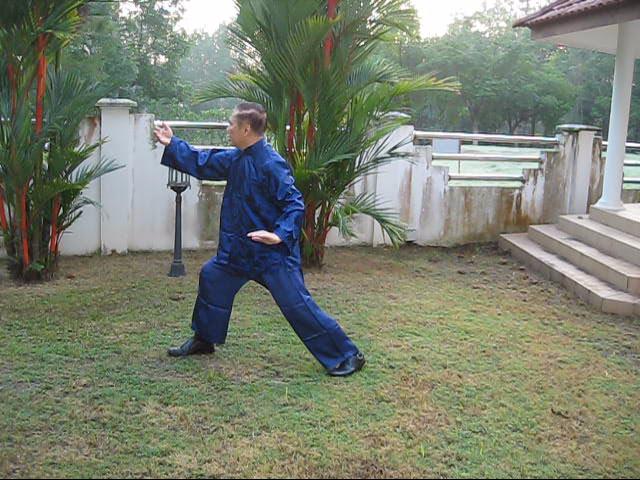WUDANG TAIJIQUAN -- DEVELOPMENT AND SPECIAL FEATURES

Wudang Taijiquan
Question
Could you please explain the development of Wudang Taijiquan and its connection to Shaolin?
-- Sifu Daniel Perex, Spain
Answer
Wudang (pronuced like /wu-tang/ in English) Taijiquan was developed by Zhang San Feng, who graduated from the Shaolin Monastery in Henan. At first it was not called Wudang Taijiquan; it was called Shaolin Kungfu.
To differentiate it from the Shaolin Kungfu practiced at the Shaolin Monastery in Henan, it was called Wudang Shaolin Kungfu. Gradually it was shortened to just Wudang Kungfu.
A few hundred years later a scholar-general, Chen Wang Ting, used the Taiji principles of yin-yang to explain the philosophy of Wudang Kungfu. Hence it was called Taijiquan, meaning Taiji or Cosmos Kungfu.
To differentiate the two styles of Taijiquan practiced on the Wudang Mountain and at the Chen Family Village, the terms Wudang Taijiquan and Chen Style Taijiquan were used. Later, Yang Style Taijiquan developed from Chen Style, and Wu Style and Sun Style developed from Yang Style.
The Wudang Taijiquan practiced by Zhang San Feng was Shaolin Kungfu at its highest level. Zhang San Feng integrated kungfu, chi kung and Zen into one unity, and performed it in an exquisite, flowing manner, aptly described as poetry in motion. It is excellent for health, combat and spiritual cultivation -- all in one.
Question
Which are the special features of Wudang Taijiquan and how did Zhang San Feng evolved this art from his past experience?
Answer
A very special feature of Wudang Taijiquan is that kungfu, chi kung and meditation are integrated into one unity. In other words, when a practitioner practices Wudang Taijiquan, he is practicing kungfu, chi kung and meditation at the same time.
This was a tremendous development in the history of kungfu. Hence, Zhang San Feng is honoured as the First Patriarch of Internal Martial Arts.
Previously a Shaolin Kungfu practitioner first practiced physical form. After he had attained a reasonably high standard, usually after many years, his teacher would teach him chi kung; or the art of energy. Then after he had attained a reasonably high standard in kungfu and chi kung, again after many years, his teacher might teach him meditation, or the art of mind training. Zhang San Feng integrated all these three arts into one so that even a beginner in Wudang Taijiquan could practice combat training, energy training and mind training as a coherent whole right at the beginning.
Zhang San Feng could do this because he was a master of all these three arts. Zhang San Feng excelled in various styles of Shaolin Kungfu, like dim mark and chin-na, numerous internal force methods, like Sinew Metamorphosis, Small Universe, Big Universe, Phoenix-Eye and Cosmos Palm. as well as many meditation techniques, like samadha, vispasana and Zen. He made full use of all these arts to develop Wudang Taijiquan.
Another special feature of Wudang Taijiquan is its flowing movement. Its patterns are not performed individually but flow continuously in a sequence. The whole set, consisting eight sequences, is performed as if it consists of only eight long patterns.
The third feature is its "softness". There seems to be no "hard" patterns in Wudang Taijiquan, whereas Shaolin Kungfu from which Wudang Taijiquan evolved was comparatively "hard". Being soft and flowing, of course, does not mean it is not forceful. Indeed, Wudang Taijiquan can be very powerful. It is high-level Shaolin Kungfu. While Shaolin Kungfu at its elementary and intermediate levels is "hard", it can be very "soft" and flowing at advanced levels.
LINKS
